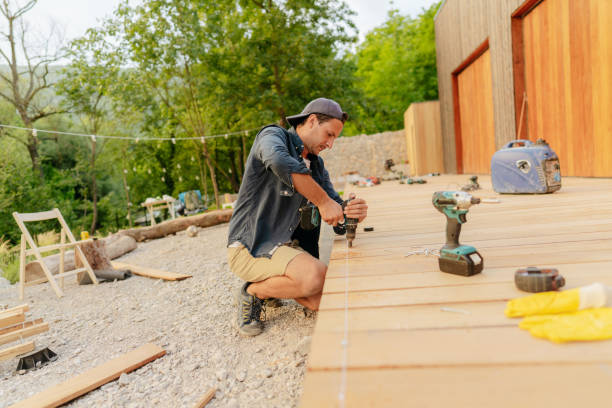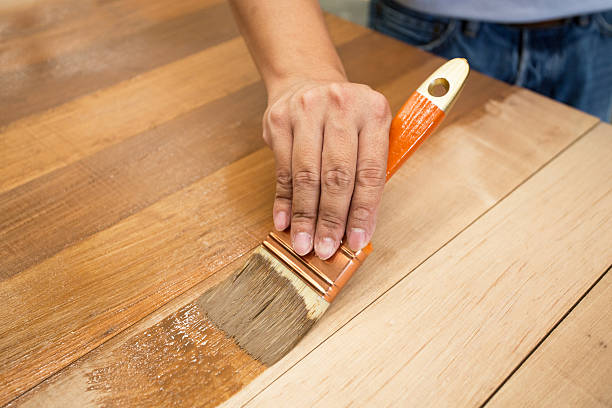Decks have become a symbol of outdoor living and a way to extend living spaces. The deck repair process starts by assessing the damage, like loose railings. Repairing involves cleaning, sanding, sealing, and replacing boards or joists. You may need to cut the damaged board section and replace it with a new piece, ensuring proper joist support. You can also address issues like sunken middles by stabilizing the deck’s frame and adding new joists. M2 Services LLC can rebuild and refresh your decks with durable materials and expert craftsmanship.
Decking Done Right: Chic Repair Hacks to Transform Your Hangout Spot
Did you just notice that the timber in your deck is splitting? If you want to restore the look of your outdoors before summer arrives, don’t fret about replacing the whole thing. Deck repair is a manageable DIY project, and repairing it can be a more cost-effective and faster alternative to a complete replacement, especially for minor to moderate damage.

Here are the essential tips for a stunning deck revival.
Assessment and Preparation
Inspect your deck and gather your tools. Look for any signs of damage, like popped nails, splintering, cracking, loose railings, rotting boards, or any signs of rot on the joists. You’ll need a pry bar, hammer, drill, circular saw, hammering tape, safety glasses, and potentially a nail puller. Ensure you have the correct type pof scews, nails, wood filler, or replacement boards.
Assessing Specific Issues
Refurbishing your deck involves the following:
- Replace the popped nails with deck screws for a more secure hold.
- Tighten or replace loose connections of railings.
- Sand por stain areas that need a refreshed look.
Resurfacing your deck is a significant repair and revolves around:
Damaged boards: Cut out the damaged section using a circular saw, jigsaw, or multi-tool. Make clear cuts. Leave some space around nails if you plan to reuse them.
Replace the boards: ensure proper joist support while replacing, with cleats or new joists.
Stain or seal: Match the stain to the rest of the deck and apply sealant to protect it.
Rotting joists: Either replace the entire joist or reinforce it with a new piece of pressure-treated lumber.
Sunken middle: Stabilize the front ridge, add a new lumber spanning the distance, and use joist hangers for support. Unfavorable footings happen due to frost heave, erosion, or excessively wet soil conditions. Reducing nearby soil erosion will help address this issue.
Loose connections: Tighten or replace screws or nails and consider using galvanized or stainless steel fasteners.
| Did you know?Wood decks need replacement after every 10 to 15 years, while composite or capped PVC decks can last for decades. |
Cleaning and Finishing
Use a mild cleaning detergent or a specialized deck cleaner to remove dirt and mildew. Sand down rough spots or uneven surfaces. Apply a sealant or stain to protect the look and the structure. Consider softwashing annually for enhanced appearance.

Prevention
- Clean your deck regularly and reapply sealant or stain every few years.
- Address problems promptly to prevent them from escalating into major issues requiring expensive repairs.
- If you want a low-maintenance option, consider composite decking, which is resistant to rot and insects.
| Interesting factBefore the mid-twentieth century, decks were not a standard feature of homes. Their popularity surged in the 1950s and 60s with the rise of suburban living and the availability of durable, pressure-treated wood. |
Conclusion
The deck repair process revolves around assessing the damage, cleaning and sanding the surface, and replacing any damaged sections of boards or joists with a new piece. Deck sealing is essential for added protection. Addressing the issues promptly and regular maintenance help prevent costly deck repairs and keep your deck looking pristine.
FAQs
Is it worth repairing my decking?
If the damage is extensive, repairs are merely a temporary solution, drawing away your money regularly. Consider replacement to save time and money in the long run.
What are the benefits of oiling a deck?
It helps prevent your deck from warping, splitting, and cracking, repels water, and protects your timber from moss growth.
How long will my wood deck last?
Expect your deck to last between 10 to 30 years for untreated wood and 50 or more years for treated wood and composite.
How do I fix a sunken middle in my deck?
Stabilize the frame, add new joists or support beams, and use joist hangers to restore proper structural integrity.
How often should I seal or stain my deck?
Reapply sealant or stain every 2–3 years to protect against moisture, UV rays, and wear.
